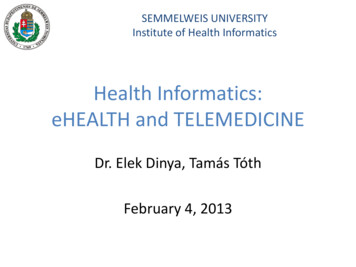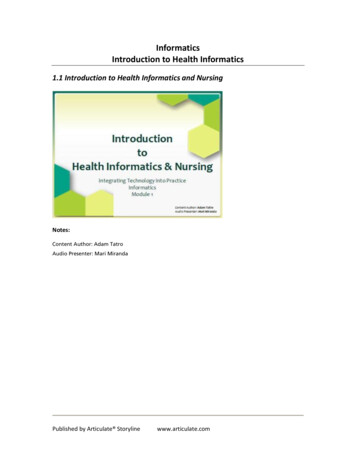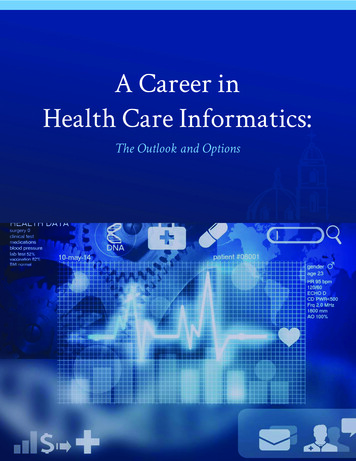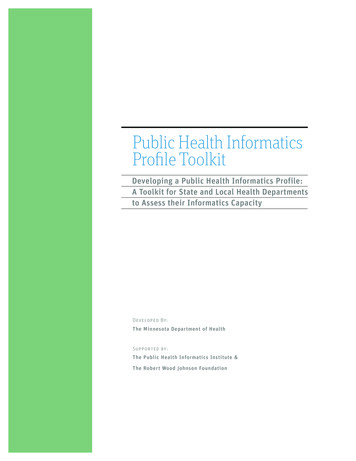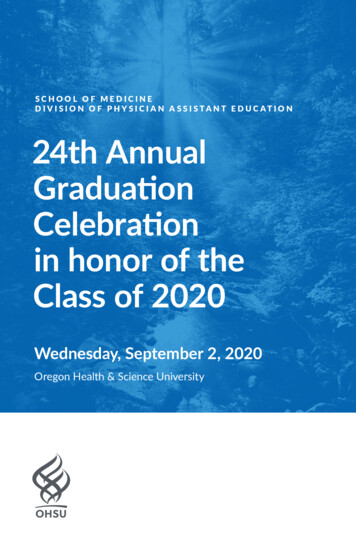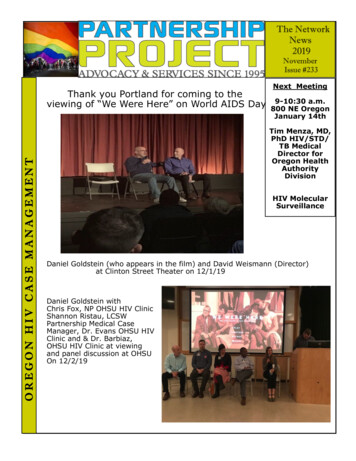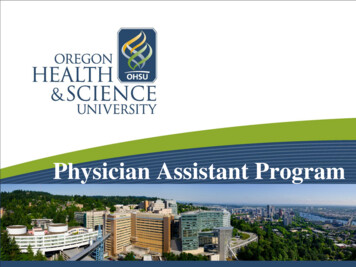
Transcription
Health InformaticsPractical Guide, 8th EditionCopyright 2022All rights reserved. No part of this book may be reproduced or transmitted in any form, by any means, electronic ormechanical, including photocopying, recording, or by any information storage and retrieval system, without writtenpermission from the publisher, except for inclusion of brief excerpts in connection with reviews or scholarly analysis.EditorWilliam Hersh, MDManaging EditorKate Fultz Hollis, MS, MBIDisclaimerEvery effort has been made to make this book as accurate as possible, but no warranty is implied. The informationprovided is on an “as is” basis. The authors and the publisher shall have neither liability nor responsibility to anyperson or entity with respect to any loss or damages arising from the information contained in this book. The viewsexpressed in this book are those of the authors and do not necessarily reflect the official policy or position of anyuniversity or government.First Edition: June 2007Second Edition: August 2008Third Edition: November 2009Fourth Edition: September 2010Fifth Edition: January 2012Sixth Edition: January 2014Seventh Edition: June 2018Print ISBN: 978-1-387-85475-2eBook ISBN: 978-1-4357-8775-9
EditorsWILLIAM HERSH, MD, FACP, FACMI, FAMIA, FIAHSIEditor-in-ChiefProfessor and ChairDepartment of Medical Informatics & Clinical EpidemiologySchool of MedicineOregon Health & Science UniversityPortland, OR, USAKATE FULTZ HOLLIS, MS, MBI, FAMIAManaging EditorInformaticianDepartment of Medical Informatics & Clinical EpidemiologySchool of MedicineOregon Health & Science UniversityPortland, OR, USA
AuthorsALEX A.T. BUI, PHDMICHELLE R. HRIBAR, PHD, FAMIAProfessor, Departments of Radiological Sciences,Bioengineering & BioinformaticsDavid Geffen School of Medicine at UCLALos Angeles, CA, USAAssociate ProfessorMedical Informatics & OphthalmologyOregon Health & Science UniversityPortland, Oregon, USAHARRY BURKE, MD, PHDWILLIAM HSU, PHDProfessor of MedicineChief, Section of Safety, Quality, and ValueDirector, DHA-USU Patient Safety andQuality Academic CollaborativeUniformed Services University of the HealthSciences Bethesda, MD, USAAssociate Professor, Departments of RadiologicalSciences, Bioinformatics, & BioengineeringDavid Geffen School of Medicine at UCLALos Angeles, CA, USAHUGO O. CAMPOSPrincipal, Consumer Health InformaticsMITRE Labs, Health Innovation CenterThe MITRE CorporationMcLean, VA, USAParticipant Partner and Community AdvisoryBoard member, All of Us Research ProgramOakland, CA, USASUSAN C. HULL, MSN, RN-BC,NEA-BC, FAMIABIMAL R. DESAI, MD, MBI, FAAP, FAMIAELIZABETH HUTCHINS, MDChief Health Informatics OfficerChildren’s Hospital of PhiladelphiaMedical Informatics Home AreaDavid Geffen School of Medicine at UCLALos Angeles, CA, USAClinical Associate Professor of PediatricsPerelman School of Medicine,University of PennsylvaniaPhiladelphia, PA, USABRIAN E. DIXON, MPA, PHD,FACMI, FAMIA, FHIMSSAssociate ProfessorDepartment of EpidemiologyIndiana University Fairbanks School ofPublic Health, Indianapolis, IN, USACenter for Biomedical Informatics,Regenstrief InstituteIndianapolis, IN, USAROBERT A JENDERS, MD, MS,FACP, FACMI, FHL7, FAMIASenior Associate Director, Clinical andTranslational Science InstituteProfessor of MedicineUniversity of California, Los AngelesCo-Director, Center for Biomedical InformaticsProfessor of MedicineCharles Drew UniversityLos Angeles, CA, USA
MICHELLE R. JONES, PHDKIRK ROBERTS, PHDAssistant ProfessorDepartment of Biomedical ScienceCedars-Sinai Medical CenterLos Angeles, CA, USAAssociate ProfessorSchool of Biomedical InformaticsThe University of Texas HealthScience Center at HoustonHouston, TX, USAKATHERINE K. KIM, PHD, MPH, MBAPrincipal, Consumer Health Informaticsand Health ScienceMITRE Corporation, Health Innovation CenterMcLean, VAAdjunct Associate ProfessorUniversity of California Davis, School of Medicine,Department of Public Health SciencesDavis, CA, USARUOWANG LI, PHDAssistant ProfessorDepartment of Computational BiomedicineCedars-Sinai Medical CenterLos Angeles, CA, USASAYANTANI SARKAR, PHDPost-doctoral ScholarUniversity of California Davis, School of Medicine,Department of Public Health SciencesDavis, CA, USASONY TUTEJA, PHARMD, BCPS, FAHAResearch Assistant ProfessorDepartment of MedicinePerelman School of MedicineUniversity of PennsylvaniaPhiladelphia, PA, USAANURAG VERMA, PHDAssociate Professor: Medical InformaticsSultan Qaboos UniversitySultanate of OmanAssistant ProfessorDepartment of GeneticsPerelman School of MedicineUniversity of PennsylvaniaPhiladelphia, PA, USAJASON H. MOORE, PHD, FACMI, FIAHSI, FASATAMARA J. WINDEN PHD, FAMIA, FHIMSSProfessor and ChairDepartment of Computational BiomedicineCedars-Sinai Medical CenterLos Angeles, CA, USAVice PresidentSanford Research and InnovationSanford HealthSioux Falls, SD, USAKEN MASTERS, PHDTHOMAS H PAYNE, MDAL RAHROOHProfessor of MedicineProfessor of Biomedical Informaticsand Medical EducationDepartment of Biomedical Informatics& Medical EducationUniversity of Washington School of MedicineSeattle, WA, USAMedical Informatics Home AreaDavid Geffen School of Medicine at UCLALos Angeles, CA, USAJOHN RASMUSSENSenior Vice President and ChiefInformation Security OfficerSyneos HealthMorrisville, NC, USAANIL YADAVDepartment of BioengineeringUCLA Samueli School of EngineeringLos Angeles, CA, USA
Table of ContentsPreface . . . . . . . . . . . . . . . . . . . . . . . . . . . . . . . . . . . . . . . . . . ix1.Introduction to Biomedical and Health Informatics . . . . . . . . . . 12.A Short History of Biomedical and Health Informatics . . . . . . . . 193.Computing Concepts for Biomedicine and Health . . . . . . . . . . . 274.Electronic Health Records . . . . . . . . . . . . . . . . . . . . . . . . . . 515.Standards and Interoperability . . . . . . . . . . . . . . . . . . . . . . . 676.Data Science and Artificial Intelligence . . . . . . . . . . . . . . . . . . 897.Clinical Decision Support . . . . . . . . . . . . . . . . . . . . . . . . . .1178.Natural Language Processing . . . . . . . . . . . . . . . . . . . . . . . 1319.Safety, Quality, and Value . . . . . . . . . . . . . . . . . . . . . . . . . 15910. Health Information Exchange (HIE) . . . . . . . . . . . . . . . . . . . 19511. EHR System Selection and Implementation . . . . . . . . . . . . . . 21112. Telemedicine and Telehealth . . . . . . . . . . . . . . . . . . . . . . . 22313. Health Information Privacy and Security . . . . . . . . . . . . . . . . 23314. Information Retrieval (Search) . . . . . . . . . . . . . . . . . . . . . . 25315. Clinical Research Informatics . . . . . . . . . . . . . . . . . . . . . . . 28316. Translational Bioinformatics . . . . . . . . . . . . . . . . . . . . . . . 29917. Nursing Informatics . . . . . . . . . . . . . . . . . . . . . . . . . . . . . 31518. Consumer Health Informatics . . . . . . . . . . . . . . . . . . . . . . . 33519. Public Health Informatics . . . . . . . . . . . . . . . . . . . . . . . . . 35720. Evidence-Based Medicine . . . . . . . . . . . . . . . . . . . . . . . . . 37721. Imaging Informatics . . . . . . . . . . . . . . . . . . . . . . . . . . . . . 39922. Ethical Issues in Health Informatics . . . . . . . . . . . . . . . . . . . .41123. Human-Computer Interaction . . . . . . . . . . . . . . . . . . . . . . 431Index . . . . . . . . . . . . . . . . . . . . . . . . . . . . . . . . . . . . . . . . . 449
Preface to theEighth EditionWelcome to the 8th Edition of Health Informatics:Practical Guide. The goal of this textbook is toprovide a comprehensive introduction to the field ofhealth informatics (also known as biomedical and healthinformatics or just plain informatics) for students. Thebook can also serve as a current update for those who arealready practitioners. As in any professional field, thereis a knowledge base and history of scientific progress ininformatics that informs current practice.The impetus for this book came from Robert Hoyt,MD, who served as the lead Editor for the first seveneditions. In preparing the 7th edition, Dr. Hoyt engagedme as a Co-Editor, with the plan for me to become theEditor of the 8th edition, and hopefully beyond. Dr. Hoytand his wife Dr. Ann Yoshihashi have been great mentorsin the process of putting a book like this together.This book is aimed at those who wish to learn aboutthe field of biomedical and health informatics (BMHI).The content is almost completely redone from previouseditions and roughly follows the current content of acourse I have taught for three decades to about 5000students in an introductory graduate course at OregonHealth & Science University (OHSU), the AmericanMedical Informatics Association (AMIA) 10x10 (“ten byten”) program, and a number of other derivative coursesfor medical students, graduate students, and health ITprofessionals. I have engaged a variety of other authorsfor many of the chapters to give additional expertise andperspective.The contents of the book aim to give a practical andbig-picture view of BMHI while providing copious references and additional readings for more detailed study.Chapter 1 introduces BMHI and its core terminology.Chapter 2 provides a brief history of BMHI, as work inthe present is often better understood by the perspective of what was done in the past to get to where wecurrently are. Although BMHI is not centrally about technology, understanding of essential computing conceptsis required, which is covered in Chapter 3.Chapter 4 covers perhaps the most central application of BMHI, the electronic health record and theclinical data within it. Chapter 5 explores the one ofthe key challenges for BMHI, namely standardization of data and its interoperability across systems.As BMHI and all of health and healthcare are beingimpacted by data science and artificial intelligence,Chapter 6 covers the accomplishments and limitationsof these areas. Chapter 7 explores the current statusand future directions for clinical decision support. Asa good deal of health information is in textual format,Chapter 8 reviews the applications and current stateof the art of natural language processing. Chapter 9explores the role of BMHI in the safety, quality, andvalue of healthcare.Chapter 10 explores the importance and implementation of exchange of health information across businessand other boundaries. As the implementation of the electronic health records is a complex process, Chapter 11covers the selection and implementation of such systems.Chapter 12 reviews the applications telemedicine andtelehealth, covering their tremendous growth in recentyears. Chapter 13 explores the critical topics of privacyand security of health information.The next few chapters move beyond the focus of directpatient care. Chapter 14 covers information retrieval(also known as search) systems that enable clinicians,researchers, and increasingly patients to find and applyknowledge for health-related decisions. Chapter 15 introduces clinical research informatics, focusing on howBMHI can improve clinical and translational research.With growing discovery of genomics and other omics,Chapter 16 explores how they are impacting health andhealthcare.These chapters are followed by those covering morefocused areas of BMHI. The critical role of nursing andinformatics in health and healthcare is covered in Chapter17. The vital role of the patient or consumer and theirinteractions with BMHI is explored in Chapter 18. Theequally critical role of BMHI in public health is describedin Chapter 19. While not all introductions to BMHIinclude coverage of evidence-based medicine, Chapter 20explores the application of the best evidence for makingclinical decisions. Chapter 21 introduces the importantrole of imaging in BMHI. The final two chapters coverix
xthe essential areas of ethical issues in Chapter 22 andhuman-computer interaction in Chapter 23.A major appreciation for this book goes to ManagingEditor Kate Fultz Hollis, who did an excellent job editingchapters and working with all the authors. She has alsodone a tremendous job at Oregon Health & ScienceUniversity (OHSU) in serving as a teaching assistantin many of my courses and a research assistant in manyof my projects. I also appreciate all those authors listedabove for completing their chapters in a timely manner.This effort and all of my other individual successeswould not have occurred without the support of thefaculty, students, and staff of the Department of MedicalInformatics & Clinical Epidemiology at OHSU.This book also would also not be possible withoutthe support of my family, including my wife Sally, mydaughter Becca, my daughter Alyssa and her husbandAJ Sowles, and the various dogs (Otis, Pheo) and cats(Cappie, Rusty) across our family.William HershJuly, 2022
1Introduction to Biomedicaland Health InformaticsWilliam Hersh, MD, FACP, FACMI, FAMIA, FIAHSIProfessor and ChairDepartment of Medical Informatics & Clinical EpidemiologySchool of MedicineOregon Health & Science UniversityPortland, OR, USALEARNING OBJECTIVESAfter reading this chapter, the reader will be able to:1. Define the core terms related to informatics4. Discuss the informatics workforce and its compo2. Define related terminology for biomedical and healthnentsinformatics5. Describe the knowledge, skills, and competencies of3. Describe how biomedical and health informatics isthose use informatics in their workan informatics science6. Find resources for further information about informaticsINTRODUCTIONThe goal of this book is to provide a practical overview of the field of biomedical and health informatics(BMHI), sometimes called health informatics (HI),which is the discipline focused on the use of information, aided by technology, to improve individual health,healthcare, public health, and research in biomedicineand health. The field is sometimes defined as the activityat the intersection of people, information, and technology. This chapter will cover the core terminologyof the field and its related terms. It will also introducethe professional workforce; the knowledge, skills, andcompetencies required of those use informatics in theirwork; and further resources for the field.Core TerminologyThe origin of the definition of informatics has beenvariably attributed to Karl Steinuch of Germany in1957(1) or Phillipe Dreyfus of France in 1962.(2) InEurope, the focus of the term has been on computingissues related to information use, which is somewhatdifferent from how we use informatics now, especially inthe context of health. The term medical informatics ispurported to first have been used in 1974.(3) At present,informatics is most substantially used in the biomedicalarena, although there are fields outside of medicine suchas legal informatics, chemoinformatics, social informatics, and so forth.The various areas within biomedical and health informatics are depicted in Figure 1. Sometimes narrowerwords appear in front of the term informatics. Other areasof biomedical and health informatics include: Bioinformatics – the application of informatics incellular and molecular biology, often with a focuson genomics Imaging informatics – informatics with a focus onimaging, including the use of systems to store andretrieve images across all types of informatics Clinical informatics – informatics applied in healthcare settings The application of informatics focused on specifichealthcare disciplines, such as nursing (nursing informatics), dentistry (dental informatics), pathology(pathology informatics), etc.1
2 Chapter 1: Introduction to Biomedical and Health Informatics Consumer health informatics – the field devotedto informatics from a consumer view, often with afocus on mobile health Clinical research informatics – the use of informatics to facilitate clinical research, with increasingemphasis on translational research that aims toaccelerate research findings into clinical practice Public health informatics – the application ofinformatics in areas of public health, including surveillance, reporting, and health promotionFigure 1. Areas within biomedical and healthinformatics (4)Imaging InformaticsResearch Informatics{Clinical field}InformaticsBioinformatics(cellular and molecular)Legal InformaticsConsumer HealthInformaticsMedical or ClinicalInformatics(person)Public HealthInformaticsBiomedical and matics People Information TechnologyShortliffe et al. describe the continuum of bioinformatics, clinical informatics, and public health informaticsas a spectrum applied from cellular and molecular processesto people to populations, although there is considerableoverlap, as exemplified through the use of genomics technologies to investigate public health outbreaks.(5) Theydefine the field of health informatics as the confluence ofclinical informatics and public health informatics.Readers may have heard this field called differentnames, such as biomedical informatics, clinical informatics, and medical informatics. Some names for the fieldfocus even more narrowly, such as medical specialties,e.g., pathology informatics, and other health professions,e.g., dental informatics and nursing informatics. Othersfocus on broader categories, such as imaging informaticsor research informatics. This author has noted that thefield has an “adjective problem,” in that there is variation in the adjective(s) preceding the word informatics.Another group of ambiguous terms includes the namefor practitioners of HCIN, who are called informaticians by some and informaticists by others. However,all of these different names for the field to have more incommon than in difference, and one definition from theAmerican Medical Informatics Association (AMIA), theprofessional association for the field, can be applied toall of them: The interdisciplinary field that studies andpursues the effective uses of biomedical data, information, and knowledge for scientific inquiry, problemsolving, decision making, motivated by efforts to improvehuman health.(6)Some earlier definitions of BMHI included thestorage, acquisition, and use of information,(7) thescience of information applied to biomedicine – dataplus meaning,(8) a paradigm shift in biomedicine fromindividual brains to systems of brains,(9) and the scienceof sociotechnical systems.(10) There have also beenEuropean and global perspectives.(11–13)Friedman defines the field from the perspective ofwhat informatics is and is not.(14) Informatics is crosstraining, where basic informational sciences meet abiomedical application domain; relentless pursuit ofassisting people; and a tower of achievement that includesmodel formulation, system development, system implementation, and study of their effects. Informatics is notscientists or clinicians tinkering with computers, analysisof large data sets per se, circumscribed roles related todeployment of electronic health records, the profession ofhealth information management, or anything done usinga computer. Friedman has also defined a fundamentaltheorem that depicts the goal of informatics, which is touse computing technologies to augment human cognitiveabilities rather than replace them.(15)This author has written a great deal on BMHI andaspects of it, including on a Web site,1 in a blog,2 and ina number of articles and chapters: Medical informatics: improving healthcare throughinformation (16) Health care information technology: progress andbarriers (17) Characterization of and changes in the profession(18) Many career opportunities (19) Reconciling definitions of terms (4) The informatics professional workforce (20)BMHI is not only important for those who work in thefield, but is a core competency of modern health professionals. According to a 2003 Institute of Medicine report,the modern healthcare professional must have competencyin informatics as part of the larger goal of providingpatient-centered care.(21) Critically important is thatinformatics competency is not just computer literacy, asthe so-called Google generation does not necessarily havegood information skills.(22) BMHI is also a core component of the learning health system.(23,24) Informatics rofessor.blogspot.com
Chapter 1: Introduction to Biomedical and Health Informatics 3a core skill for all modern health-related endeavors. It iscertainly as essential skill for healthcare professionals,who must have competence in the use of key applicationsfor patient care, such as the electronic health record andits critical functions, such as clinical decision support andorder entry.(25) The ability to find and apply knowledgeis also a critical skill in modern times.(26)Related TerminologyWe can also gain more perspective about informatics bynoting how the field is distinguished from related subjects.The term information technology (IT) generally refers tocomputers and related technology. Computer science is anacademic discipline that focuses on the scientific aspectsof computing and IT. A related discipline is managementinformation systems, which is another field underlying ITthat is usually taught in business schools. We sometimessee the use of the term health information technology(HIT or health IT), which generally refers to the health- related application of IT.Another set of related terms falls under health information management (HIM), which is the disciplinehistorically focused on management of (paper) medicalrecords (changing in current environment), with threemain levels of practice: Registered Health Information Administrator(RHIA) – highest level, baccalaureate degree Registered Health Information Technologist(RHIT) – associate degree Certified Coding Specialist (CCS) – usually lessthen associate degreeAnother term gaining use is digital health, whichis a broad term for digital, i.e., IT-related, aspects ofhealth and healthcare.(27) This term emanates frominformation and communications technology (ICT),which is essentially same as IT with added emphasis ontelecommunications. Similar terms include eHealth,which is the use of ICT for health, and mHealth, whichinvolves the use of mobile devices for health. There aregrowing efforts in digital health around in the world,from the United States3 to Australia4 to Asia.5Another set of related terms are the “tele” terms.These include telemedicine, which is the provision ofhealthcare when participants separated by time and/ordistance. A related term is telehealth, which adds italhealth-pacific-guide3pursuit of health when separated by time and/or distance,although these terms are frequently used interchangeably.Sometimes the clinical discipline is added to the term,e.g., telepathology or teleradiology.Another related term is health systems science (HSS),which is defined as a new science for medicine, differentfrom basic and clinical science. There is a textbook (28)that includes chapter on clinical informatics,(29) andthis subject is increasingly incorporated into medicaleducation.(30)There are some other terms that focus on the applicationof evidence to clinical practice, often using BMHI tools.Evidence-based medicine (EBM) is the application ofthe best scientific evidence in medical decision-making.(31) Evidence-based practice (EBP) is the applicationof EBM in patient care. Comparative effectivenessresearch (CER) is research that compares one or morediagnostic or treatment options to evaluate effectiveness, safety or outcomes (also called patient-centeredoutcomes research). Information retrieval (also knownas search, part of larger knowledge management) is thefield devoted to searching (mostly text, mostly knowledge-based information).(26)There are also terms related to medical or clinicalrecords. The electronic health record (EHR) refers tothe patient’s health record in digital form and has mostlysupplanted the older term, electronic medical record(EMR). The personal health record (PHR) refers tothe personally controlled health record. An importantfunction of EHRs and other clinical data is health information exchange (HIE), which refers to the exchange ofhealth information across traditional business and otherboundaries (a verb). The organization managing HIE usedto be called a Regional Health Information Organization(RHIO), but is now called by some an HIE (a noun).Informatics is also essential for modern biomedicalresearch. Noted in the National Institutes of Health (NIH)Roadmap6 to accelerate biomedical research discovery isthe following observation: Today’s biomedical researcherroutinely generates billions of bytes of data. There isno way to manage these data by hand. Researchers needcomputer programs and other tools to evaluate, combine,and visualize these data. In some cases, these tools willbenefit from the awesome strength of supercomputersor the combined power of many smaller machines. Inother cases, these tools will be used on modern personalcomputers connected to data and resources in the cloud.There are important terms to know for informaticsapplied to clinical research. Translational s/overview
4 Chapter 1: Introduction to Biomedical and Health Informaticsclassically, the translation of basic research into clinical applicability (“bench to bedside”), but also fromcontrolled settings to community and population.(32)There is increasing recognition that clinical research findings must “translate” into clinical care more quickly andefficiently, leading to US government investment in clinical and translational research through the NIH Clinical& Translational Science Award (CTSA) program.(33)Translational bioinformatics is bioinformatics appliedto health-related problems.(34) Precision medicine isclinical care tailored to an individual’s characteristics,including their genome.(35,36) It was previously calledpersonalized medicine.(37) The importance of informatics in research has led to a subdiscipline of clinicalresearch informatics (CRI), which is the area of informatics applied to clinical research.(38) The differencebetween information technology (IT) and informaticsis very evident in this domain.(39)A growing field related to informatics is data science.(40) Data science is “the science of learning fromdata; it studies the methods involved in the analysisand processing of data and proposes technology toimprove methods in an evidence-based manner.”(41)Data science includes the area of data analytics, whichis “the extensive use of data, statistical and quantitativeanalysis, explanatory and predictive models, and factbased management to drive decisions and actions.(42)Another well-used term is Big Data, referring to datathat meets the categories of the four Vs: Volume, Velocity,Variety, and Variability.(43) There are other related datascience terms. Machine learning is ability of computerprograms to learn without being explicitly programmed(44) or, the use of computers to optimize a performancecriterion using example data or past experience.(45) Thecurrent most successful approach to machine learninginvolves use of neural networks; when using multiplelayers, called deep learning.(46) Another term usedin this context is artificial intelligence (AI), which isactually an older term referring to information systemsand algorithms capable of performing tasks associatedwith human intelligence.(47,48)How is informatics different from data science? Payneet al. describe a process cycle of going from biological,social, or technical processes with afferent and efferentloops of going to and from knowledge respectively.(49)Data science and informatics focus on generating knowledge but informatics is more broadly engaged in the useof that knowledge in real world of health, healthcare,research and other areas.Blum introduced the notion of a continuum fromdata to information to knowledge.(50) According tothis perspective, data are the raw material collected andstored. Information gives meaning and organization tothe data. Knowledge provides understanding and applicability to new situations. Some add a fourth term tothis continuum, which is wisdom, defined as knowinghow to apply knowledge.(51) Bernstam et al. more fullyelaborate the different views of the continuum.(8) Theynote that data consist of symbols, with a lack of uniformity. Information is then considered to be data that isprocessed to be useful or given meaning. Informationanswers questions such as who, what, when, and where.Knowledge then consists of justified or true belief and isapplied to data and information to answer questions ofhow. Wisdom provides understanding of why questions.Biomedicine as an Information ScienceMedicine is commonly thought of as a life science,but some point to observations that may more appropriately call it an information science. Clinicians spendsubstantial amounts of their time gathering and analyzinginformation to make decisions based on it. Many studiesover the years, even from the era before computers, foundphysicians spend great deal of time with information.A study from 1973 found that physicians in a generalmedicine outpatient clinic spent about 37.8% of their timecharting, 5.3% consulting, 1.7% in other activities, andremainin
a code for health informatics.8 Unfortunately this call was unheeded, and health informatics was lumped into a category of Health Information Analysts and Medical Registrars, under which "health informatics specialist" was considered an illustrative example.9 The lack of a specific SOC code for health informatics makes its
